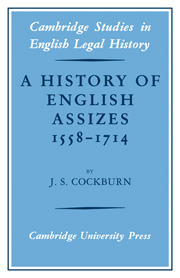Book contents
- Frontmatter
- Contents
- Dedication
- Preface
- List of Abbreviations
- INTRODUCTION
- Part One THE STREAMS OF PARADISE
- Part Two ASSIZES AND GAOL DELIVERY
- 4 Preliminary proceedings
- 5 The clerk of assize and his staff
- 6 Criminal proceedings
- 7 Nisi prius
- Part Three THE PLANETS OF THE KINGDOM
- APPENDICES
- Bibliography
- Index
5 - The clerk of assize and his staff
Published online by Cambridge University Press: 07 October 2011
- Frontmatter
- Contents
- Dedication
- Preface
- List of Abbreviations
- INTRODUCTION
- Part One THE STREAMS OF PARADISE
- Part Two ASSIZES AND GAOL DELIVERY
- 4 Preliminary proceedings
- 5 The clerk of assize and his staff
- 6 Criminal proceedings
- 7 Nisi prius
- Part Three THE PLANETS OF THE KINGDOM
- APPENDICES
- Bibliography
- Index
Summary
Before turning to the judicial activity of assizes, something must be said of the clerical organization responsible for the records and smooth working of the assize courts.
On each circuit the administration of assizes rested with a small professional body headed by a clerk of assize. This office undoubtedly attained early distinction and formalization, though the process by which it did so is uncertain. From an early date concentration of responsibility for clerical and administrative work on each circuit was probably considered desirable. As early as 1285–before the assize system itself had reached a finished form–it was laid down that itinerant justices should be accompanied by clerks responsible for enrolling pleas. But the authenticating of judicial records was not without problems. Theoretically the records of the courts at Westminster rested in the breasts of the judges presiding there. Given that it was necessary to provide judges going circuit with some form of expert assistance, two courses were open. Clerks of assize might be appointed by Crown patent, but the record would then cease to be that of the judges, and this would raise many problems; alternatively, an assize judge might use his own private clerk–an expedient apparently adopted for a time during the fourteenth century–or take with him one of the court clerks, who would then act as a private agent.This was equally dangerous, for although court clerks were dependent on the Bench and could therefore be controlled, a voluntary clerk of assize could not be called to account.
- Type
- Chapter
- Information
- A History of English Assizes 1558–1714 , pp. 70 - 85Publisher: Cambridge University PressPrint publication year: 1972
- 1
- Cited by



